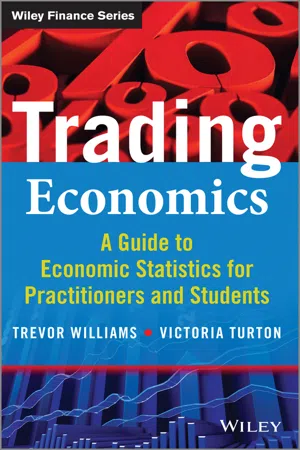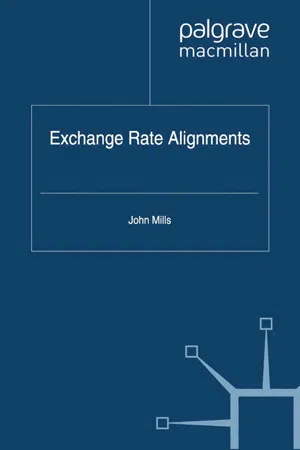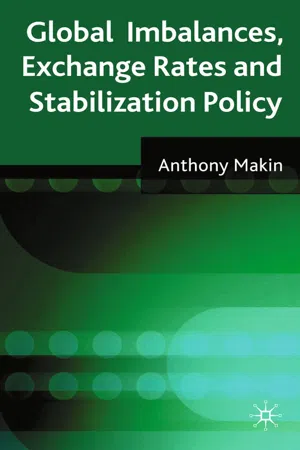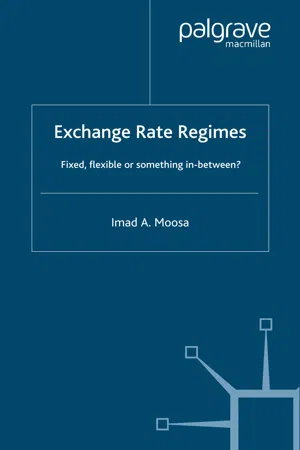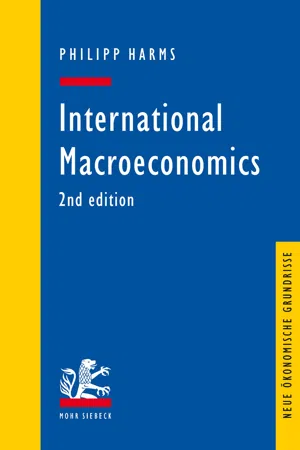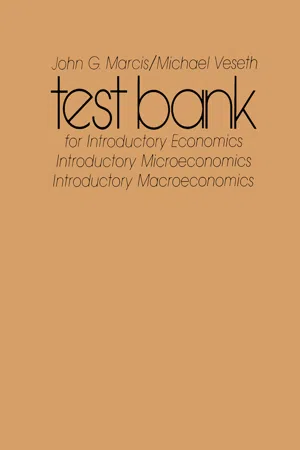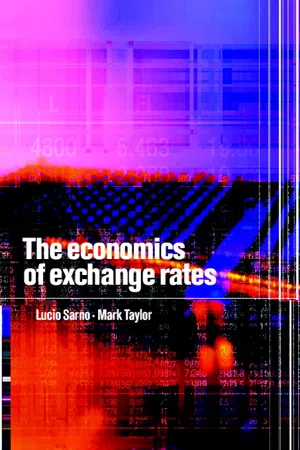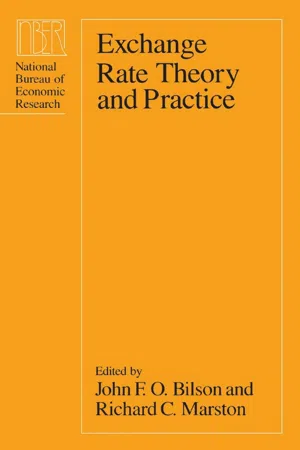Economics
Inflation and Real Exchange Rates
Inflation and real exchange rates are interconnected economic concepts. Inflation refers to the general increase in prices of goods and services, leading to a decrease in the purchasing power of a currency. Real exchange rates, on the other hand, take into account inflation and reflect the relative price levels between two countries. Changes in inflation can impact real exchange rates and international trade competitiveness.
Written by Perlego with AI-assistance
Related key terms
1 of 5
11 Key excerpts on "Inflation and Real Exchange Rates"
- eBook - PDF
Trading Economics
A Guide to Economic Statistics for Practitioners and Students
- Trevor Williams, Victoria Turton(Authors)
- 2014(Publication Date)
- Wiley(Publisher)
4 Inflation Inflation is always and everywhere a monetary phenomenon in the sense that it is and can be produced only by a more rapid increase in the quantity of money than in output. Milton Friedman 1 WHAT IS INFLATION? Inflation tells us the changing (increasing) price of a range of goods or services; basically how much of something we can get for our money. The rate of change of prices – the speed at which the price of goods and services that are bought by households or businesses alter – is called inflation. But prices can also fall, in a process called deflation, sometimes termed negative inflation. Inflation is more common than deflation, or at least it has been in the last 50 years or so, and so it has become associated with changes in the price of goods and services. Historically, however, price falls were as common as price rises, as we will see later. Both inflation and deflation have advantages and disadvantages, which we will explore in more detail later in this chapter. THE HISTORY OF INFLATION Inflation has been around for a long time, but, as Figure 4.1 shows, the level of prices (the index) really only rose consistently and sharply in the UK from the 1970s onwards. This was after the US came off the gold standards and the Bretton Woods system of fixed exchange rates, which had prevailed after the Second World War, ended. Money was now backed by government fiat and trust rather than by gold. And exchange rates were no longer fixed but allowed to float freely. This seems to have led to a rapid rise in the level of prices or, in other words, to the Retail Prices Index. Before that, for hundreds of years, the level 1 Friedman, M., The Counter-Revolution in Monetary Theory (1970). 100 Trading Economics Retail Price Index (1987 = 100) 0 10 20 30 40 50 60 70 80 90 100 1264 1296 1328 1360 1392 1424 1456 1488 1520 1552 1584 1616 1648 1680 1712 1744 1776 1808 1840 1872 1904 1936 1968 2000 Figure 4.1 Price index over time. - eBook - PDF
- J. Mills(Author)
- 2012(Publication Date)
- Palgrave Macmillan(Publisher)
There is much evidence that the problems with inflation are more diverse and more manageable than is often recognised. Devaluation and the price level Those who believe that exchange-rate changes will affect prices are right in at least one sense. Any parity reduction is bound to exert upward pressure on the costs of all imported goods and services in the devaluing country. While the prices measured in the domestic currency of both imports and exports will almost certainly rise, the tendency for import costs to increase faster than export prices may worsen the terms of trade. In this sense, too, there is a direct cost to the economy. Furthermore, there is no value in a policy of depreciation unless it makes imports more expensive rela- tive to home market production. A major objective has to be to price out some imports by making it relatively cheaper than it was previously to produce locally rather than in other countries. It follows that without price increases for imported goods and serv- ices, there will be no new bias towards production from domestic output. 46 Exchange Rate Alignments The evidence presented in Table 3.1, however, indicates that other factors have to be taken into account. If, as is commonly supposed, only import prices were significant, then the figures in the table would show increasing inflation and declining living standards after a depreciation and not, generally speaking, the opposite. How then are the figures in the table to be explained? The answer is that devaluation’s impact on the price level is more complicated than is often recognised. Many effects are disinflationary rather than the reverse and tend to increase national income rather than reduce it. Obviously, the more exposed an economy is to foreign trade, the greater the immediate impact of exchange-rate changes on living standards and the price level. - eBook - PDF
- Marek Dabrowski(Author)
- 2003(Publication Date)
- Central European University Press(Publisher)
The first and most direct one covers the transmission of exchange-rate changes on the prices 86 Disinflation in Transition Economies of imports and exports of goods and services, in terms of the domestic currency. The prices of imported final goods immed iately rise in the event of a domestic-cur rency depreciation. At the same time the overall price level is also pushed up, due to increases in the cost of imported fuels, raw materials, and semifinished industrial products. This effect is often called a cost-push inflat ionary pressure. The same occurs to export prices, which also rise because of the domestic-currency depreciat ion. Following price increases of imports and exports of goods and service s, demand, and con-sequently the prices of their sub stitute s, will also increase. The overall effect of exchange-rate changes on prices depends both on the share of foreign trade in GDP and on the product structure of exports and imports. The extent to whic h the domestic market is open and free of monopolies is also important. The lower the entry cost s and the less mon op olistic the market, the more pronounced the price effect of exchange-rate changes (Rybinski 1998). The second exchange-rate-inflation channel operates throug h wages. Wages in industries affected by changes in the exchange rate tend to expe-rience pressure. In addition, such changes affect the cost ofliv ing, which results in wage claims (Dornbusch 1995). The third channel is connected with the negative impact of currency depreciation on the demand for domestic money. This effect is more inten-sified in transition economies with poorly develope d financial markets, fresh memories of high inflat ion and devaluation, and high levels of dol-larization. The actual and expected rate of a currency depreciat ion creates expec-tations of future changes in price levels, according to the transmission mechanisms describe d above. - A. Makin(Author)
- 2009(Publication Date)
- Palgrave Macmillan(Publisher)
143 9 Monetary Policy and the Real Exchange Rate Introduction The conduct and effectiveness of monetary policy has changed markedly over recent decades as capital markets have become more internationally integrated, external imbalances have widened and exchange rates have become more variable. Inflation targeting is also now a primary goal of monetary policy in many advanced and emerging economies. Yet in this financially globalized context, many unresolved questions remain about the nature of the monetary policy transmission mechanism under floating exchange rates. For instance, how does a change in the monetary stance influence real exchange rate adjustment and external imbalances? How do inflationary expectations at home and abroad affect inflation and the real economy? How important are changing interest risk premia and foreign interest rate movements to domestic monetary policy settings? And how do cyclical and productivity shocks in the real sector affect competitiveness, the current account and inflation over the medium term? This chapter aims to provide clear-cut answers to these questions with reference to an international macroeconomic framework that links aggregate production, aggregate demand, interest rates, exchange rates, expectations, domestic and foreign price levels and external account imbalances. This distinct approach contrasts with more traditional interna- tional monetary models that incorporate transnational capital flows, such as the MF framework which is widely used for interpreting the 144 Global Imbalances, Exchange Rates and Policy impact of real and monetary shocks in open economies. The MF model remains central to textbook macroeconomics and has proven so durable because it delivers clear macroeconomic policy prescrip- tions about national income stabilization under alternative polar exchange regimes.- eBook - PDF
Exchange Rate Regimes
Fixed, Flexible or Something in Between?
- I. Moosa(Author)
- 2006(Publication Date)
- Palgrave Macmillan(Publisher)
When the real exchange rate makes the economy highly P P = α + βEP ∗ P ∗ Figure 2.3 The effect of domestic currency appreciation and rising foreign prices on domestic prices The Role of the Exchange Rate in the Economy 31 competitive, resources are drawn into the traded goods sector, which is mirrored in the factor market by a new allocation of resources. The economy becomes trade-oriented, with rising employment of capital and labour in the export- and import-competing sectors. The distribu- tion of income is also affected. If the country has a traditional export sector (for example, agriculture or mining), then a very competitive exchange rate will make traditional exports profitable. There are also implications for the asset markets. When domestic returns are below foreign returns, capital flight will occur, leaving a smaller amount of resources available for domestic investment. Moreover, those who indulge in capital flight (for example, those who can fake trade invoices) often do so at the expense of those who do not (perhaps because they cannot). Exchange rate policies/regimes affect the external balance and the internal balance through their effects on total spending (via the demand for money) and on the competitiveness of traded goods. According to Collier and Joshi (1989), the external balance should be interpreted as the achievement of a sustainable current account deficit (a deficit that is consistent with a realistic medium-run projection of foreign capital inflow). The internal balance is a more complex target as it has Inflow i – i ∗ Outflow Inflow Inflow Outflow Outflow E e + ρ ⋅ Figure 2.4 Interest and exchange rate configurations and capital flows 32 Exchange Rate Regimes employment (or output) and inflation as its components. Policy-makers would like to have high employment and output and low inflation, but complications are introduced by the fact that there may be a trade-off between these sub-targets (as implied by the Phillips curve). - eBook - PDF
- Harms, Philipp(Authors)
- 2016(Publication Date)
- Mohr Siebeck(Publisher)
27 Recall from (7.22) that, if the law of one price holds for all goods, variations in the terms of trade directly affect the real exchange only if there is a home bias in consumption. 28 Note that we are sidelining an even bigger conceptual question – namely, whether an economy’s “competitiveness” is actually reflected by its ability to export more than it imports. 29 The GDP deflator is the ratio of nominal GDP over real GDP, with the latter measuring domestic output at constant prices. Its level thus reflects the prices of all goods and services produced in an economy, including investment goods. VII.5 The Real Exchange Rate and Net Exports 299 (7.28) H PPI t F PPI t t PPI t P P E Q , , For some applications, finally, it may be more appropriate to capture a country’s cost competitiveness by computing real exchange rates based on countries’ unit labor costs (ULC) . Unit labor costs are determined by dividing a country’s total wage sum by real GDP. Accordingly, the ULC-based real exchange is given by (7.29) H t H t H t F t F t F t t ULC t Y L W Y L W E Q with i t W denoting the average nominal wage, i t L denoting total employment, and i t Y denoting real GDP in country i (with F H i , ). Defining average labor productivity in country i as the ratio of GDP over employment, i.e. i t i t i t L Y A / , and using lower-case letters to denote (natural) logarithms, we can transform the expression in (7.29) into (7.30) H t H t F t F t t ULC t a w a w e q A real depreciation – i.e. an increase of the ULC-based real exchange rate – thus occurs if domestic wage increases are less pronounced than domestic productivity increases (both relative to the foreign country). In Figure 7.9, we depict the evolution of the CPI-based , GDP deflator-based and ULC-based real effective exchange rate for the Euro area. It strikes the eye that, despite the very different definitions and conceptual underpinnings, the three time series largely move in parallel. - eBook - PDF
Test Bank for Introductory Economics
And Introductory Macroeconomics and Introductory Microeconomics
- John G. Marcis, Michael Veseth(Authors)
- 2014(Publication Date)
- Academic Press(Publisher)
e. economic statistic which describes how real income is related to nominal income. 50. Inflation is generally defined as: (80) a. a decrease in the general level of prices. b. an increase in the prices of selected items. C. an increase in the general level of prices. d. a decrease in the prices of selected items. e. a program which ties wages, values and/or taxes to a price index. 51. Consumers paid $125 for a particular basket of goods and services in 1980 and paid $ 150 for the same basket in 1981. What was the annual rate of inflation between 1980 and 19817(92-94) a. Approximately 17 percent. B. Approximately 20 percent. c. Not enough information has been provided. d. Approximately 117 percent. e. Approximately 120 percent. 52. Consumers paid $34.50 for a particular basket of goods and services in 1970 and paid $52.90 for the same basket in 1977. What was the annual rate of inflation between 1970 and 19777(92-94, Tab. 4-2) A. Approximately 53 percent. b. Approximately 67 percent. c. Not enough information has been provided. d. Approximately 47 percent. e. Approximately 33 percent. 53. Consumers paid $100 for a particular basket of goods and services in 1979 and paid $ 150 for a different basket of goods and services in 1981. What was the annual rate of inflation between 1979 and 19817(92-94) a. Approximately 50 percent. b. Approximately 33 percent. C. Not enough information has been provided. d. Approximately 67 percent. e. Approximately 100 percent. 54. According to Veseth, a price index: (81) a. is a book which firms use to determine prices. B. is an approximate measure of the cost of a fixed market basket of goods relative to the same basket in a base period. c. cannot be computed for an economy because the total number of goods in the economy is so large. d. is an approximate measure of the cost of a market basket of goods relative to another basket of goods in a base period. - eBook - PDF
- Lucio Sarno, Mark P. Taylor(Authors)
- 2003(Publication Date)
- Cambridge University Press(Publisher)
3 Purchasing power parity and the real exchange rate The purchasing power parity (PPP) exchange rate is the exchange rate between two curren-cies which would equate the two relevant national price levels if expressed in a common currency at that rate, so that the purchasing power of a unit of one currency would be the same in both economies. This concept of PPP is often termed ‘absolute PPP’. ‘Relative PPP’ is said to hold when the rate of depreciation of one currency relative to another matches the difference in aggregate price inflation between the two countries concerned. If the nominal exchange rate is defined simply as the price of one currency in terms of another, then the real exchange rate is the nominal exchange rate adjusted for relative national price level differences. When PPP holds, the real exchange rate is a constant so that movements in the real exchange rate represent deviations from PPP. Hence, a discussion of the real exchange rate is tantamount to a discussion of PPP. Although the term ‘purchasing power parity’ was coined as recently as eighty years ago (Cassel, 1918), it has a very much longer history in economics. 1 While very few contem-porary economists would hold that PPP holds continuously in the real world, ‘most instinc-tively believe in some variant of purchasing power parity as an anchor for long-run real exchange rates’ (Rogoff, 1996), and indeed the implication or assumption of much reasoning in international macroeconomics is that some form of PPP holds at least as a long-run rela-tionship. 2 Moreover, estimates of PPP exchange rates are important for practical purposes such as determining the degree of misalignment of the nominal exchange rate and the appro-priate policy response, the setting of exchange rate parities, and the international comparison of national income levels. It is not surprising, therefore, that a large literature on PPP, both academic and policy-related, has evolved. - eBook - PDF
International Macroeconomics
A Modern Approach
- Stephanie Schmitt-Grohé, Martín Uribe, Michael Woodford(Authors)
- 2022(Publication Date)
- Princeton University Press(Publisher)
• The existence of an international border separating the two locations. This can reflect the presence of nominal exchange rate volatility, local currency price rigidity, cross-border regulations, import and export tariffs, and trade quotas. • The existence of nontradable goods. Nontradable goods are goods that are domestically produced, but are neither importable nor exportable. • If the weights on prices that enter the consumer price index differ across countries, then variations in relative prices can lead to variations in real exchange rates. If domestically produced goods make up a bigger share of the domestic basket than of the foreign basket and hence receive a larger weight in the home country’s price index than in the foreign country’s price index, then we say there is home bias in consumption. • The imposition of import tariffs or export subsidies makes the country more expensive relative to the rest of the world; that is, it causes a real exchange rate appreciation. • The optimal price index assigns weights to individual prices that correspond to the weight of the associated good in the consumer’s utility function. When nominal income is deflated by the optimal price index, variations in real income represent variations in welfare in the same direction. 9.11 Exercises Exercise 9.1 (International Price Convergence) The figure displays the real exchange rate of 10 hypothetical countries relative to China in 2010 and the change in the real exchange rate between 2010 and 2020. 1. What countries were less expensive than China in 2010 and became even cheaper after 10 years? 2. What countries, if any, were more expensive than China in 2010, but less expensive than China in 2020? 3. What countries, if any, were less expensive than China in 2010, but more expensive than China in 2020? 4. - eBook - PDF
- John F. Bilson, Richard C. Marston, John F. Bilson, Richard C. Marston(Authors)
- 2007(Publication Date)
- University of Chicago Press(Publisher)
The long-run expected rate of inflation having already been determined, the determination of the long-term real interest rate requires only the speci- fication of an equation for the long-term nominal interest rate. This is done by inverting a demand-for-money equation in which the long-term rate of interest represents the opportunity cost of holding money. In the resulting equation (7), it is expected that a lower real money stock leads, by itself, to a higher nominal interest rate, while the sign of the coefficient of the ex- pected long-run inflation term is indeterminate.6 The last term in equation (7) represents an expected liquidity squeeze or glut, which should have a positive coefficient. As explained in Artus (1981), when a shift to monetary restraint leads to a downward shift in the long-run expected growth rate of money, the slow speed of price adjustment will lead private market partici- pants to expect that the real money stock is going to decline. The excess of the short-run over the long-run expected inflation rate will indicate how se- vere the liquidity squeeze is likely to become in forthcoming quarters. If this excess is large, private market participants will bid up the interest rate in anticipation of the forthcoming squeeze. The exchange rate block is based on the asset market theory of exchange rate determination. In the equation that explains the change in the DM/$ exchange rate, the three explanatory variables are the expected inflation rate differential, the change in the uncovered short-term interest rate differential, and the relative current balance position of Germany and the United States.’ A derivation of this equation was presented in Artus (1981, appendix 1). One of the results of the derivation was that the introduction of the relative current balance position could be justified on two grounds. First, the substi- tutability of domestic and foreign securities may be limited. - Thomas Grennes(Author)
- 2019(Publication Date)
- CRC Press(Publisher)
By partially delinking the current from the capital account, all the dual rates system can hope to do is delay the eventual crisis. A system that is particularly relevant for the developing countries consists of the coexistence of a fixed rate for commercial transactions with a floating parallel (either black or grey) market rate governing the financial transactions. 9 3. MEASURING REAL EXCHANGE RATES From an empirical point of view, the first question that should be addressed is: How should the real exchange rate be measured? From equation (9), which defines the real exchange rate as the relative price of tradables and nontradables, it is apparent that the main measurement problems are those related to the selection of the real-world counterparts of P; and P N In reality, it is extremely difficult, if not impossible, to define which goods are actually tradables and which are nontradables. A second measurement problem is related to the definition of E. Should the nominal exchange rate with respect to the U.S. dollar be considered? Or is the exchange rate with respect to the DM the most appropriate? Or should an average of both rates be used? These and other problems related to the measurement of the real exchange rate will be discussed in this section. The analysis will be restricted to the actual measurement of the RER without entering into the important and difficult question of the empirical definition of the equilibrium level of the real exchange rate. The analysis presented in this section will first discuss briefly the arguments traditionally given favoring alternative measures of the real exchange rate. The discussion will be quite general and will provide a broad cover of the literature. That is, the presentation will also deal, even though briefly, with the PPP real exchange rate. Section 4, on the other hand, deals with the actual behavior of different RER indexes in the developing countries.
Index pages curate the most relevant extracts from our library of academic textbooks. They’ve been created using an in-house natural language model (NLM), each adding context and meaning to key research topics.
